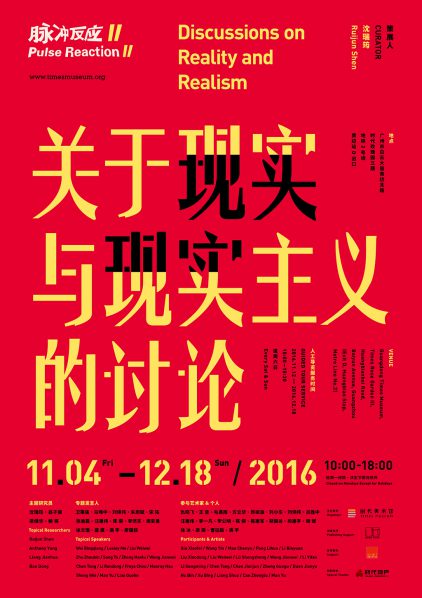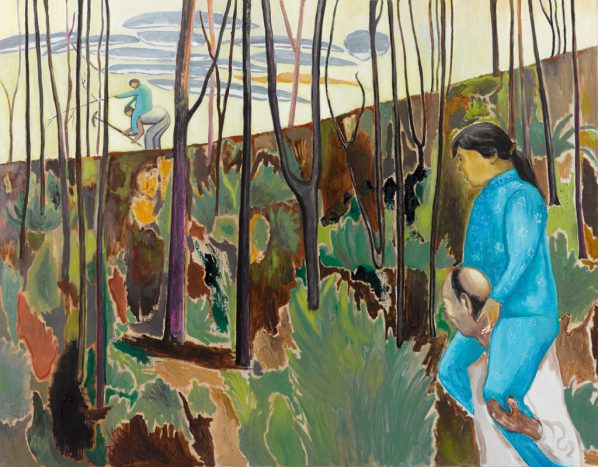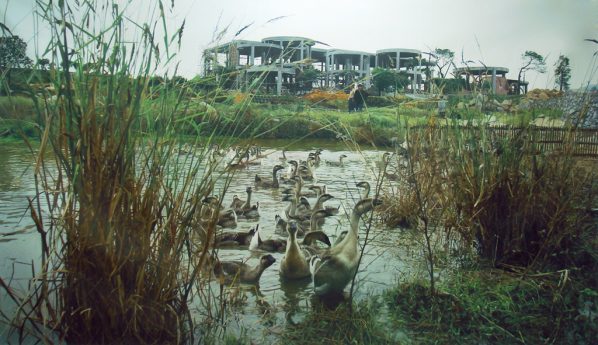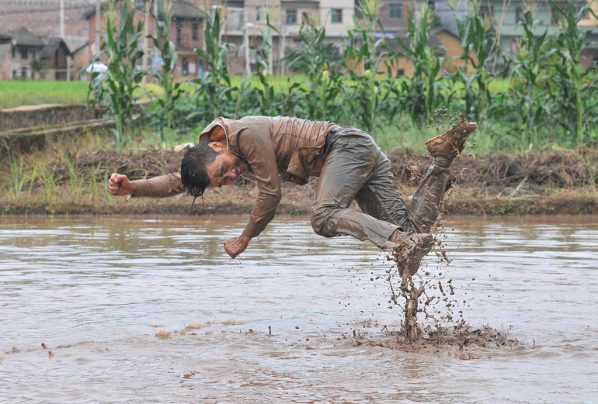
Pulse Reaction II – Discussions on Reality and Realism
By Shen Ruijun
Continuing in the model of Pulse Reaction I of providing a platform for the exchange of ideas between Chinese contemporary art practitioners, Pulse Reaction II invites 32 artists and scholars to Times Museum to carry out four days of intensive discussion on themes relating to reality and realism. The discussions, research projects and artworks related to this event will be on display at Times Museum.
Realism as a method of artistic expression was introduced to China during the New Cultural Movement. Owing to the specific needs of China, and a series of cultural policies such as The Talks at the Yan’an Forum on Art and Literature, the discursive system of realism came to dominate the mainstream of Chinese literary and artistic creation. Through the art education system, the exhibition system and art criticism, this line of thinking came to have a profound impact on the artistic language and modes of thought among several generations of artists. The discussion of realism is in order to take stock of the effect this discursive system has on us, to examine our cognitive foundations with a serene mindset, to further open up the Chinese reality with its many details and contradictions, and to further explore the various possibilities for artists to engage in the artistic transformation of this reality. The discussion will revolve around the four themes of “Two Kinds of Realism”, “On the Countryside”, “Social Intervention Is Not What Matters” and “Truth.” The discussion will touch on many topics, including The Talks at the Yan’an Forum on Art and Literature, the roots and impact of the discursive system of realism, the Chinese experience and the agrarian awareness at the root of its society, painting practice in the countryside, the relationship between the social reality and art, and the concept that “everyone is an artist.” By compiling related documents and presenting related artworks, we hope to create within the museum a field for the concentrated exchange of ideas, open different dimensions of China's contemporary reality and artistic intervention therein, and explore ways for the individual spirits of artists to apply and confront the rich material of reality.

Xu Bing, Harvest's End, 1982; print, 14.6x15.3cm; Courtesy of the artist
Schedule
November 4th
Liang Jianhua: Social Intervention Is Not What Matters
Back in 2003, scholar Li Gongming raised the issue of the sociological turn in contemporary art. This quickly led to a heated debate about whether such practice is qualified as art. It was not until 2010, when a group of artists residing in the 008 Art District took to the streets to resist forced eviction that the true thread behind this topic truly began to emerge.
Forget Fear, the 2012 Berlin Biennale, made it no longer possible to ignore the so-called social intervention art in China, and split Chinese practitioners into two camps. One side believes that such practice has departed from the realm of art, while the other believes that art has always been a force for social progress, and that intervention in reality is the original intent of artistic practice.On the individual level, each artist turns to “social intervention”from a different point. But they all share a dissatisfaction with the ways in which market forces have shaped the judgment of so-called “good artworks”since the entry of capital into Chinese art. Looking back to the League of Left-Wing Writers in the early 20th century, and The Talks at the Yan’an Forum on Art and Literature, we see that working methods for entering deeply into the texture of society are not a new development. This thread continues to Joseph Beuys’conviction that“everyone is an artist”and his proposition of the concept of “social sculpture.” These precedents demonstrate that in the existing context, social intervention is more than just an aesthetic shift under the logic of “relational aesthetics.” Artists who hold this view universally believe that artistic practice must return to the current context and aim directly at the issues therein. They are unsatisfied with art only playing a role within its own specialized field. They believe that art has always existed within society, and that it is impossible to investigate artistic practice stripped of its context. From this perspective, these artists disagree with the definition of such practice as “social intervention.”
Thus, in Pulse Reaction II, invited artists will be asked to engage with such topics as “how to recognize the history of leftist practice”,“what context includes”,“the legacy of Joseph Beuys”in an attempt to clarify the viewpoints, epistemological foundations and logic underlying various forms of“social intervention”creations.
10:30-12:30
Panel Discussion: The History of Left Wing Artistic Practices
A focused re-examination of early 20th century left wing artistic practices from the perspective of the present.
Moderator: Liang Jianhua
Participants: Li Randong, Li Gongming and Man Yu
14:00-16:00
Panel Discussion: The Legacy of Joseph Beuys
A discussion of the artist's working methods referencing two key concepts:
“everyone is an artist” and “social sculpture”.
Moderator: Liang Jianhua
Participants: Man Yu, Liu Weiwei, Chen Jianjun and Mao Chenyu
16:00-17:00
Panel Discussion: What Does Context Entail
Researchers with different views will express their judgments on their
surrounding context
Moderator: Liang Jianhua
Participants: Li Yifan, Li Randong
17:00-18:00
Round Table Discussion: What Does Context Entail

Duan Jianyu, Sharp, Sharp, Smart No. 11, 2015; Oil on canvas, 140x180cm; Courtesy of Vitamin Creative Space and the artist
November 5th
Bao Dong: Realism as a Discourse
Two Kinds of Realism
There are two terms in Chinese,“xianshi zhuyi”and “xieshi zhuyi,”that both translated to “realism,” but they have different meanings in different art history contexts. The first, “xianshi zhuyi,” refers specifically to an artistic and literary movement that began in themid-19th century. In art, it is the realism represented by Gustave Courbet, which is often listed alongside the classicalism and romanticism of the same period. The second term, “xieshi zhuyi,” refers broadly to artistic ideas of representational illusion dating back to the Renaissance in Europe, including such techniques as perspective, anatomy, lighting and color theory. The discourse of the two terms overlap, but not completely. For a long time in China, however, little distinction was made between the two terms, and with the establishment of the discourse of Socialist Realism (which uses “xianshi zhuyi”), the two were treated as interchangeable, which led to many concrete combinations of realist (xianshi zhuyi) concepts and realist(xieshi zhuyi) techniques, such as plein air painting in the countryside. In fact, one of the first expressions of contemporary Chinese painting was the loosening and decoupling of these two terms. From the perspective of linguistics and semiotics, whether it is “reality” in the social sense or“truth” in the visual sense, they both have rhetoric effects, and the two encompass a series of semiotic operations.
10:30-12:30
Presentation: China's Millet—the Growth of Realism from France to China
Lecturer: Sheng Wei
Presentation: Realism-Discourse and Utility
Lecturer: Zhu Zhoubin
14:00-18:00
Presentation: Two Kinds of Realism
Lecturer: Bao Dong
Panel Discussion: Two Kinds of Realism: Xianshi zhuyi, Xieshi zhuyi and Live Study
Moderator: Bao Dong
Participants: Liu Xiaodong, Wang Yin, Qiu Xiaofei, Sheng Wei, Zhu Zhoubin and others

Zheng Guogu, Imperial Telepathy No. 3, 2009; Oil on canvas, 210x365cm Courtesy of Vitamin Creative Space and the artist
November 6th
Ruijun Shen: On the Countryside
According to the censuses of 1982 and 2011, the rural population accounted for 79.7% and 50.1% of the nation's total population, respectively. China is still a giant nation of farmers. There is a unique aspect of Chinese art activities and education of taking arts and literature to the countryside, which is rooted in the Talks at the Yan’an Forum on Art and Literature. This system has been continued by Chinese art academy education ever since. How has it influenced the ways in which Chinese contemporary artists see reality and reflect life? In his book From the Soil, sociologist Fei Xiaotong writes, “Chinese society is fundamentally rural.” Rural society is embodied in interpersonal relations rooted in agriculture. Meanwhile, in a certain sense, urbanization and modernization are synonymous. The contradiction between the “rustic” air of the countryside and the “cosmopolitan” air of the cities is a contradiction between two modes of thought. In China, where urbanization is progressing with increasing intensity, how is the mixing of these two modes of thought embodied in the national reality? This study sifts through “rural” or “rustic” themed artworks since the 1980s in an effort to engage discussion and thinking of rural or rustic issues. It invites artists and scholars to explore the insights and influences that a Chinese society in transition between old and new has for art.
10:30-11:15
Presentation: The Spectacle of the Chinese Countryside in the Comics of He Youzhi
Lecturer: Chen Tong
11:15-12:30
Panel Discussion: The Countryside in the Eyes of Artists
Moderator: Ruijun Shen
Participants: Chen Tong, Fang Lihua, Duan Jianyu, Liang Shuo, Zhu Zhoubin, Hu Bin
14:00-15:00
Presentation: On the Countryside
Lecturer: Ruijun Shen
15:00-16:00
Panel Discussion: Rural Society
Moderator: Ruijun Shen
Participants: Liu Xiaodong, Li Yifan, Li Binyuan, Liang Shuo, Sheng Wei
16:00-17:00
Panel Discussion: “Rustic” and “Cosmopolitan”—the Phenomenas and Aesthetics of the Urban-Rural Divide and the Overlap between Old and New
Moderator: Ruijun Shen
Participants: Duan Jianyu, Liang Shuo, Bao Dong, Sheng Wei, Li Yifan, Li Binyuan
17:00-18:00
Panel Discussion: Literature and Art Going Down to the Countryside (Arts Policy) and the Instrumentalization of Art
Moderator: Ruijun Shen
Participants: Liu Xiaodong, Bao Dong, Sheng Wei, Chen Tong, Zhu Zhoubin, Wang Jianwei, Hu Bin

Li Binyuan, Freedom Farming, 2014; video-documentation of performance, 5’02''; Courtesy of the artist
November 7
Anthony Yung: Truth
The theme of “Truth” comes from the earliest plan proposed by the curator of Pulse Reaction II, to revisit the debate over “realism” that took place in the 1980s in China. The importance of this art history event, touched on artistic concepts throughout the twentieth century, has not faded to this day. This debate has its own unavoidable historical thread, but in our own thread today, it is essential to continue its key points. The reason this discussion expands the concept of “realism” into“truth” is that as the practices and theories of contemporary art have developed, the greatest breakthrough on this issue has been that we no longer need to struggle over what the “truth” is (just as we no longer struggle over what “art” is) so that we can place it in a position of authority. Instead, we can employ the “truth” as a flexible conceptual tool as we decode each unique case. In this way, it can lead to a rich questioning mentality, with such questions as, why do artists choose or choose not to use “truth” as a creative principle? How can uncertainty and incorrectness be read as “truth”? How to communicate and reconcile between the subject’s truth and the shared truth? What is the “role of the truth” in the fiction and even deception in art? The invited artists and theorists will draw from their respective practices, as well as contemporary theory, philosophy and anthropology to engage in an open discussion on the “truth.”
10:00-12:30
Each artist delivers a lecture and discussion with curator, approximately 30-40 minutes. Four sessions in total.
14:00-17:00
Round Table Discussion
Moderator: Anthony Yung
Participants: Manray Hsu, Freya Chou, Wei Bingqiang, Liao Guohe, Wang Jianwei, Song Ta, Zhang Hanlu\
About the exhibition
Curator: Ruijun Shen
Exhibition Period: 2016.11.04 – 2016.12.18
Venue: Guangdong Times Museum, Times Rose Garden III, Huangbianbei Road, Baiyun Avenue, Guangzhou (Exit D, Huangbian Stop, Metro Line No.2)
Opening Hours: Tue – Sun, 10:00-18:00 (closed on Mondays except for holidays)
Admission: RMB 10
Guided Tour Service: 2016.11.12 – 2016.12.18, 15:00-15:30, Every Sat & Sun
Tel: + 8620 26272363
Topical Researchers: Ruijun Shen, Anthony Yung, Liang Jianhua, Bao Dong
Speakers: Wei Bingqiang, Liu Weiwei, Zhu Zhoubin, Song Ta, Zhang Hanlu, Wang Jianwei, Chen Tong, Li Randong, Freya Chou, Manray Hsu, Sheng Wei, Man Yu, Liao Guohe
Artists and Participants: Qiu Xiaofei, Wang Yin, Mao Chenyu, Fang Lihua, Li Binyuan, Liu Xiaodong, Liu Weiwei, Lü Shengzhong, Wang Jianwei, Li Yifan, Li Gongming, Chen Tong, Chen Jianjun, Zheng Guogu, Duan Jianyu, Hu Bin, Xu Bing, Liang Shuo, Cao Zhenglu, Man Yu
*In order by stroke count of last nameOrganizer: Guangdong Times Museum
Publishing Support: Guangzhou Zaidi Culture Co.Ltd.
Support:Asia Art Archive
Special Thanks:Times Property
Courtesy of the artist and Guangdong Times Museum, for further information please visit www.timesmuseum.org.




























